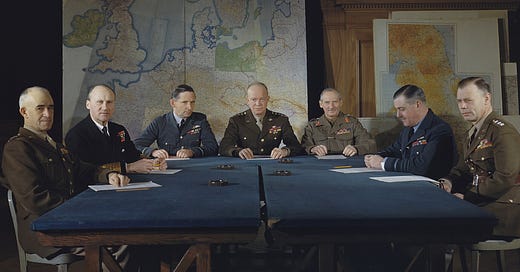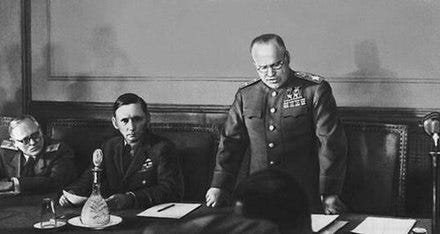Adolf Hitler is assumed to have died on April 30 1945 when he shot himself in the head. Assumed because there were no convincing remains of him or of his bride Eva Braun. She bit into a cyanide capsule; a ghastly wedding present considering she’d waited so long for the marriage. She first met Hitler in 1929 and was presumably keen because in 1932 she shot herself in the chest probably in a bid to attract his attention. As Shakespeare said, the course of true love never did run smooth. Hitler’s death certificate was finally issued in 1956 after a long investigation.
So it was a murky end to the dictator. And the war he unleashed had an equally confused conclusion.
Victory in Europe (VE Day) is celebrated in the west on 8th May. Victory Day is celebrated in Russia and much of eastern Europe on 9th May. And it’s not solely down to different time zones although this played a part. It’s about national pride, one-upmanship and a dollop of paranoia.
The First World War ended in various armistices and treaties. Many Germans considered the Versailles treaty unfair and vindictive (although it was less harsh than those imposed on the Ottoman and Austro-Hungarian empires which were dismantled). The Nazis used this discontent to help their seizure of power and subsequent unleashing of World War Two. Because of this, the Allies were desperate to ensure there could be no doubt about the end of the Second War and spent all of 1944 hammering out a policy. The vital agreement was that the capitulation of Germany should be unconditional and recorded in a single document.
At first it was intended that this be signed by German authorities but the British in particular doubted there would be any government left in Germany with the authority to sign. So instead, this requirement was replaced by a unilateral declaration of total German defeat, the dissolution of the state and assumption of supreme authority by the Allies.
Eisenhower chairing a meeting of the western allies’ Supreme Command February 1944. Bradley looks worried, Ramsey ponders getting the army across the channel, Tedder looks decisive, Eisenhower in charge, Montgomery pleased with himself, Leigh-Mallory examines his nails and Bedell Smith on the look out for trouble.
Then it gets even more complicated because of the aforementioned pride, one-upmanship and paranoia. The German Instrument of Surrender was actually signed twice. The first time was in Reims France on 7 May by the Allied Chief of Staff, Walter Bedell Smith on behalf of the Supreme Command of the Allied Expeditionary Force. (Sitting above right.) General Ivan Susloparov signed on behalf of the Soviet High Command and Alfred Jodl for Germany.
Kenneth Strong, who features in my books, is standing behind Jodl.
However, General Susoparov was a fairly junior General and sent a message to Moscow to ask if he was authorised to sign. He got no reply so he decided it would be best if he did so. Shortly after he got a message ordering him not to sign. Whoops.
The Soviets objected because the Reims’ agreement had not explicitly ordered the German forces to lay down arms and give themselves up (paranoia), because they wanted the surrender to be signed in the German capital Berlin and not a formerly occupied territory (national pride) and because they wanted acknowledgement that the main contribution to the German defeat was by the Soviet people and not the Allies (one-upmanship.)
Geneal Eisenhower, Supreme Allied Commander, agreed to all of this and organised a second surrender ceremony in Berlin. Because Eisenhower outranked Marshal Zhukov, it was agreed that the surrender should be signed by the Deputy Supreme Commander, the British Air Chief Marshal Arthur Tedder, who was the same rank as Zhukov.
Zhukov reading the German capitulation with Tedder beside him.
It was not settled yet, however. Charles de Gaulle insisted that one of the signatories should be French (national pride, paranoia and one-upmanship) but the Soviets were adamant that there could be only three Allied signatures.
In the end it was agreed that the surrender be signed by Zhukov and Tedder with the French General de Tassigny and the American General Carl Spaatz as witnesses. Luckily Eisenhower was a politician even more than a soldier and did not throw his toys out of the pram at what might well been considered a snub. So alone of all the Allied Powers, no American actually signed the surrender.
Muddled though it was, there could be no dispute that the war in Europe was over. And because of this and incredibly wise and generous post war policies we have not suffered a third world war. Let’s just hope there aren’t too many leaders who suffer from pride, paranoia and one-upmanship. Fingers crossed.







I didn't know the shenanigans that went on with the treaty, so it was very interesting, even more so because today 9th May is the Channel Islands Liberation Day. The day after French Liberation, the British soldiers came ashore in landing craft and Naval Officers raised the Union Flag out of the harbour masters office window. All reenacted every year in a day of celebration